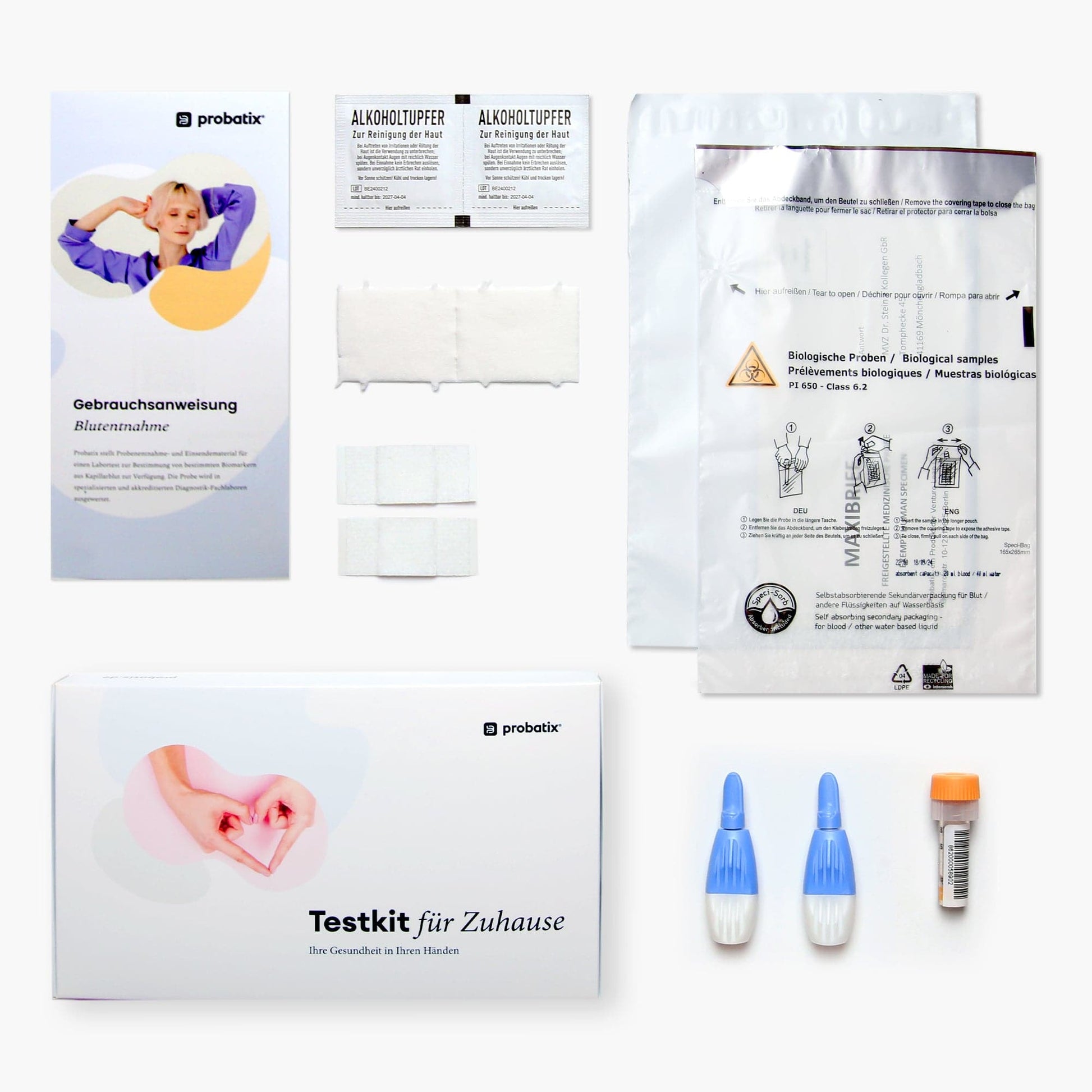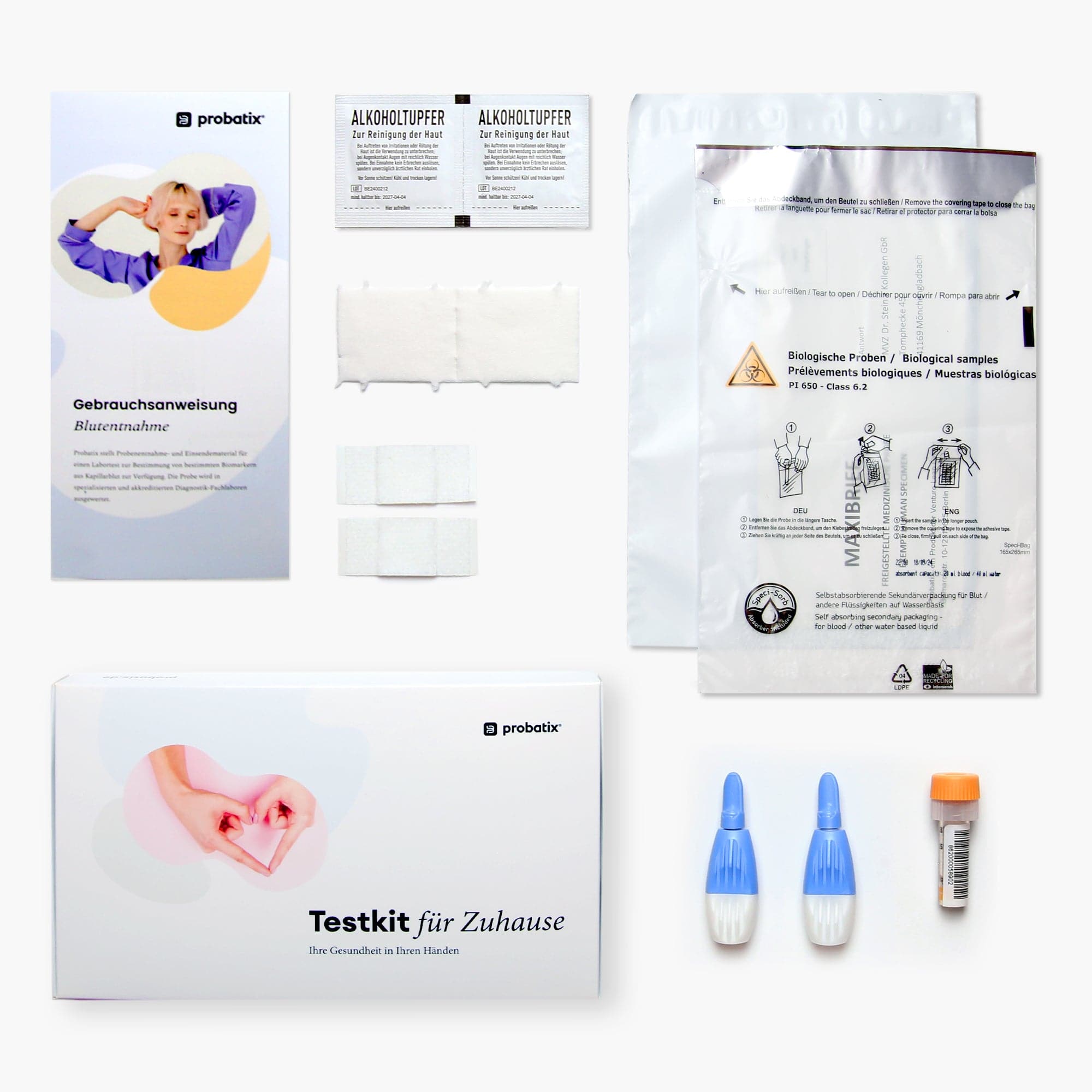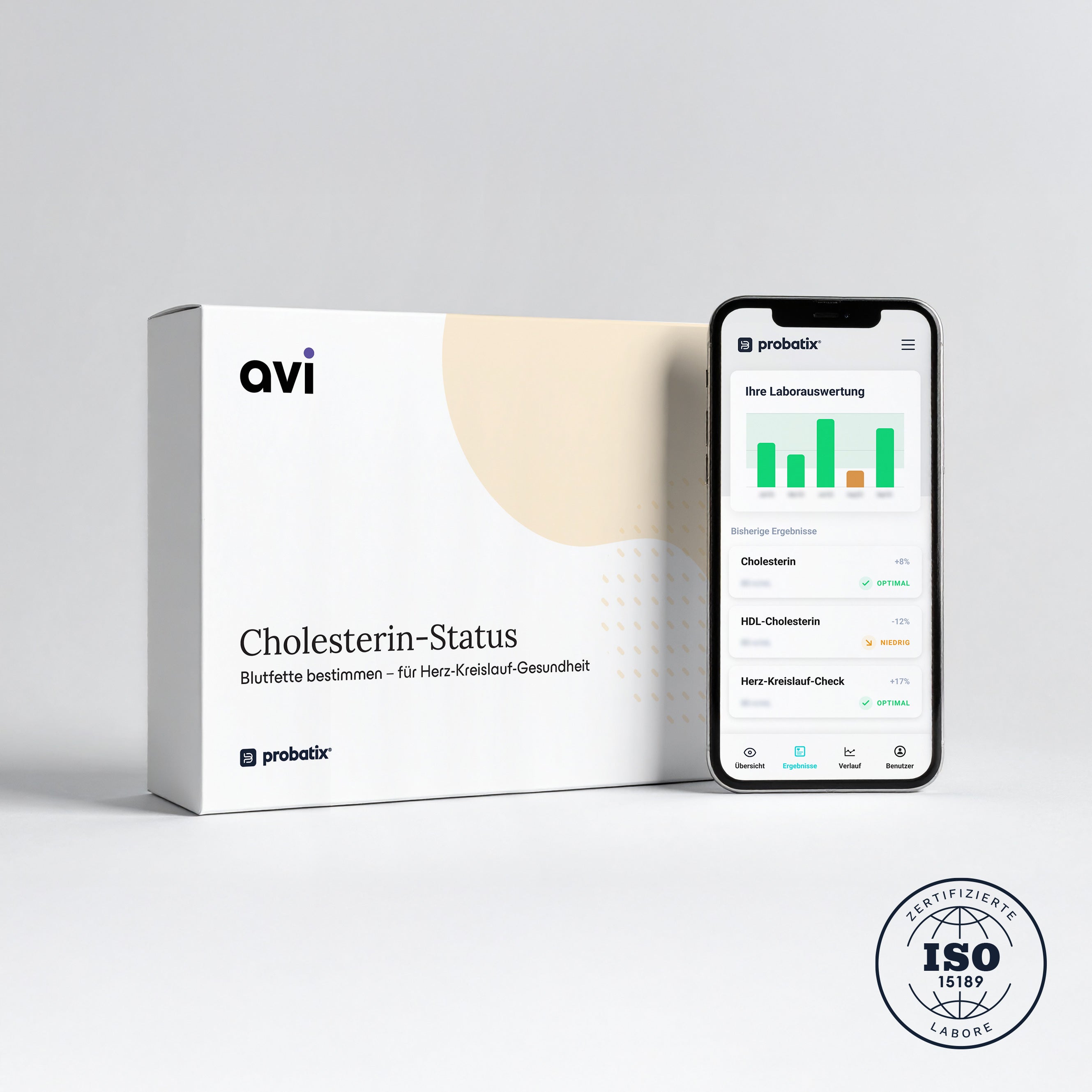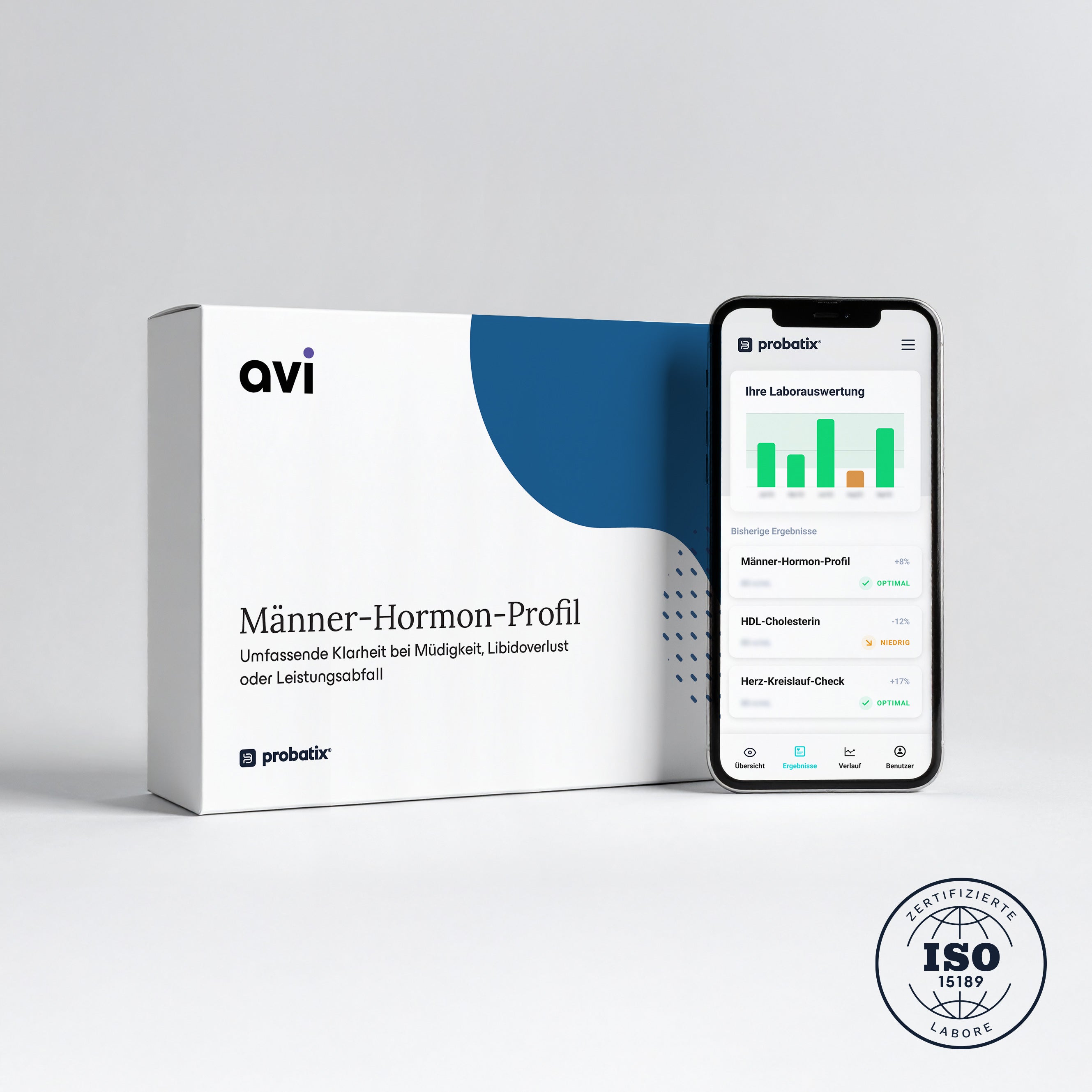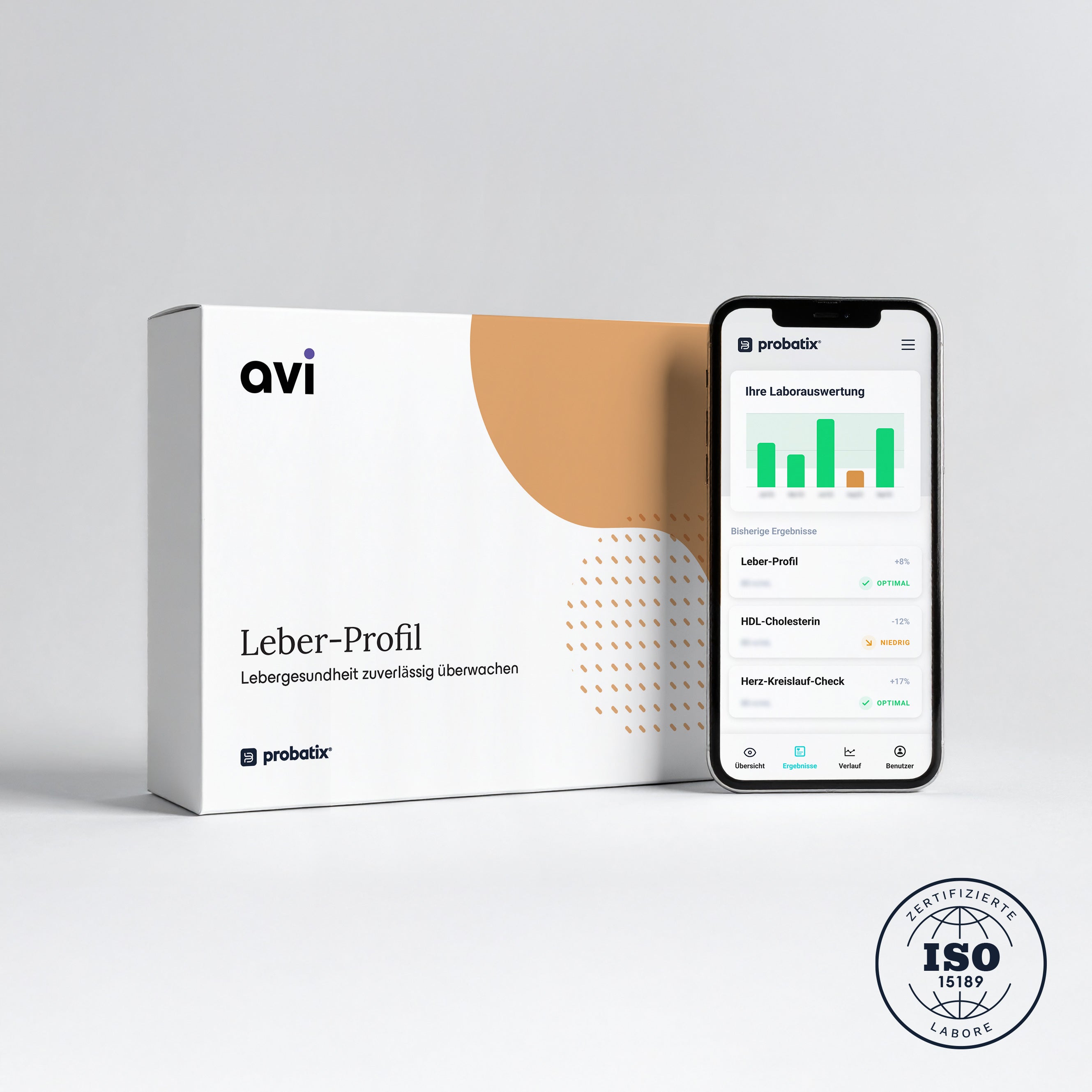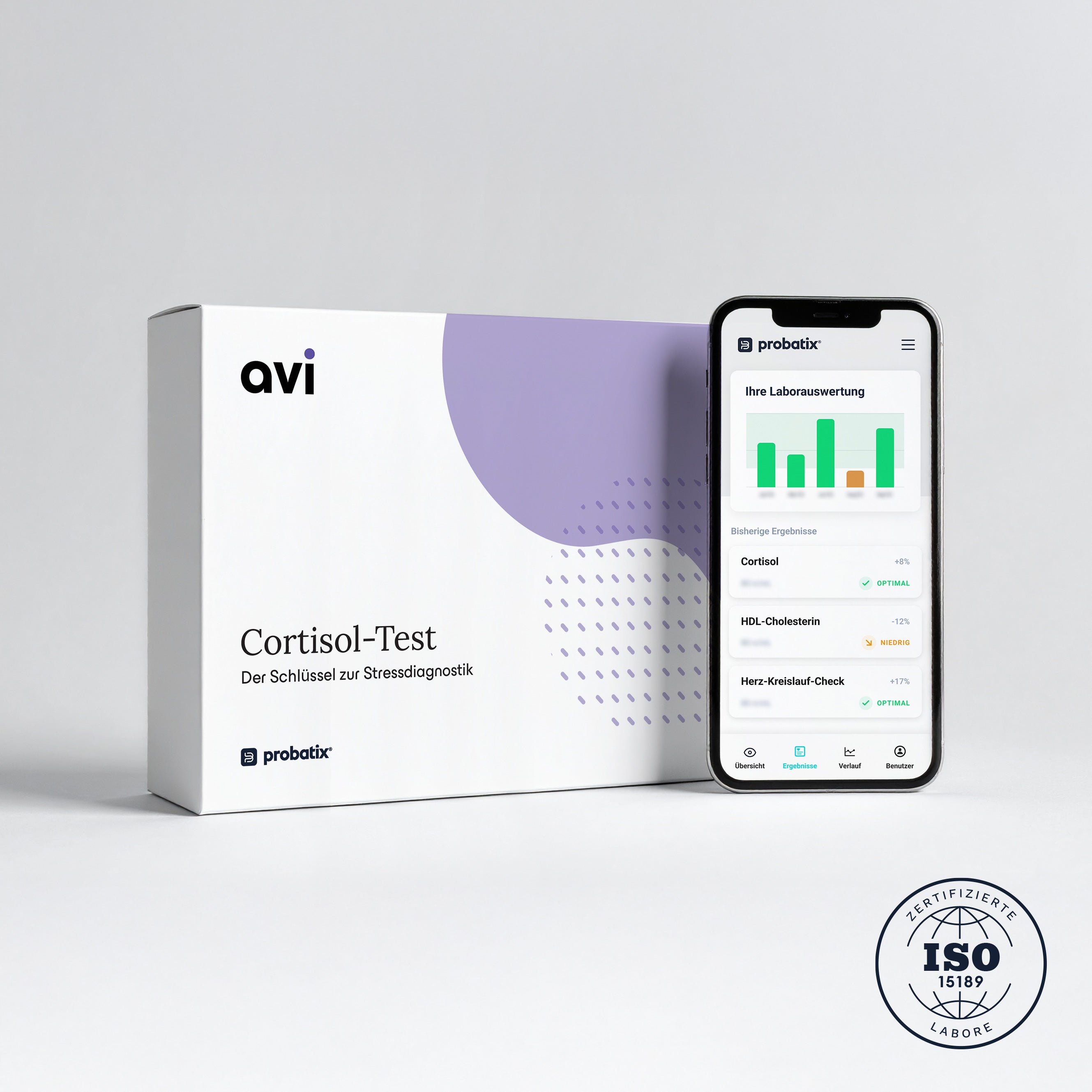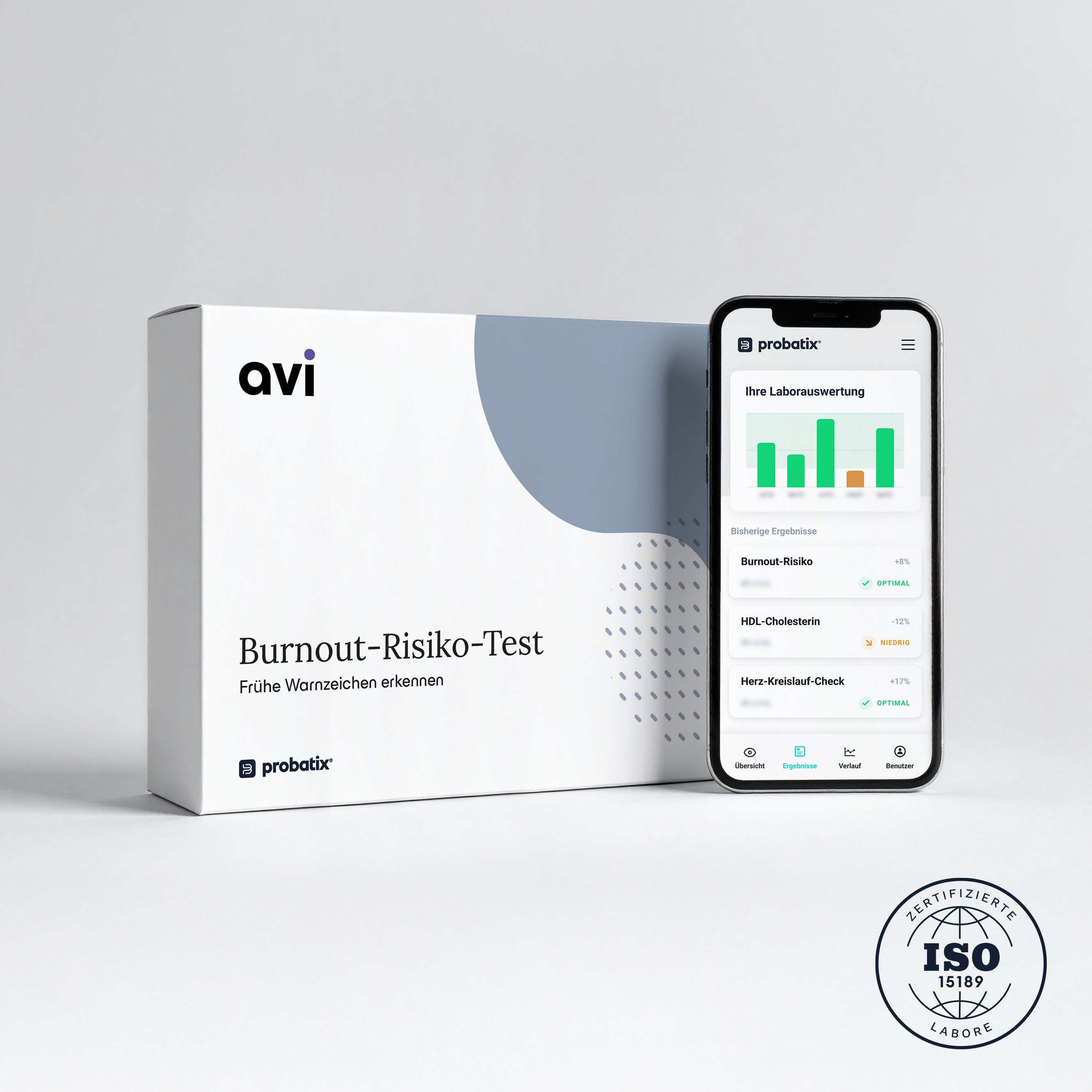Menopause Profile
Menopause Profile
The Menopause Profile helps you better understand the hormonal changes during peri- and postmenopause. During this phase of life, symptoms such as hot flashes, sleep disturbances, mood swings, or weight gain often occur, which can be triggered by hormonal changes.
With the analysis of Estradiol (E2), FSH, LH, Progesterone (total), SHBG, and TSH, you get a clear picture of your current hormonal balance. This allows you to identify the causes of symptoms and derive appropriate measures to alleviate and support your quality of life.
- Comprehensive Analysis: Determination of key hormones for the menopause transition.
- Simple && discreet: Blood sample conveniently from home, professionally evaluated in the lab. html
- Clear feedback: Your results are clearly presented and compared with reference ranges.
Keep an eye on your hormonal health – for more security and quality of life during menopause.
avi begleitet Sie – besprechen Sie anschließend Ihre Ergebnisse einfach per Video mit Ihrer Ärztin oder Ihrem Arzt.
➡️ Buchen Sie jetzt Ihren Termin bei aviIn stock
What values does this test measure?
What values does this test measure?
Further information on the values can be found here.
How does it work?
How does it work?
1. Take a sample with our test kit
2. Send the sample to the lab with the prepaid envelope
3. View results digitally after a few days
Why are the values reliable?
Why are the values reliable?
All tests offered by us are evaluated and validated in certified medical laboratories in Germany.
This is what the press says about our tests
Menopause Profile: All details about the test
What benefits does this test offer me?
What benefits does this test offer me?
Das Wechseljahre-Profil bietet Ihnen eine detaillierte Analyse wichtiger Hormone, die sich in den Wechseljahren stark verändern. In dieser Lebensphase kommt es häufig zu Symptomen wie Hitzewallungen, Schlafstörungen, Stimmungsschwankungen, trockener Haut, Gewichtszunahme oder verminderter Libido. Diese Beschwerden hängen oft direkt mit hormonellen Ungleichgewichten zusammen.
Mit der Untersuchung von Estradiol (E2), FSH, LH, Progesteron (gesamt), SHBG und TSH erhalten Sie wertvolle Einblicke in Ihr hormonelles Gleichgewicht. So können Sie besser verstehen, ob Ihre Beschwerden durch den natürlichen Hormonrückgang der Wechseljahre oder durch andere Ursachen bedingt sind.
Die Ergebnisse helfen Ihnen dabei, gemeinsam mit Ihrer Ärztin oder Ihrem Arzt individuelle Entscheidungen zu treffen – zum Beispiel über Lebensstiländerungen, unterstützende Therapien oder den möglichen Einsatz einer Hormonersatztherapie. Auf diese Weise gewinnen Sie Sicherheit im Umgang mit den Veränderungen und können Ihre Lebensqualität aktiv verbessern.
Nutzen Sie die Chance, Ihre hormonelle Situation rechtzeitig zu erfassen – für mehr Klarheit und einen gesunden Übergang durch die Wechseljahre.
What do the measured values mean?
What do the measured values mean?
Estradiol (E2) is the most important estrogen in the body and plays a central role in fertility and the female cycle. It is predominantly produced in the ovaries, and in smaller amounts in the testes and adrenal glands in men. Estradiol also influences bone metabolism, the skin, and the cardiovascular system.
High estradiol levels can be found, for example, during ovulation, pregnancy, or hormone therapies. Low levels occur during menopause and can be associated with symptoms such as hot flashes, sleep disturbances, or bone loss.
Follicle Stimulating Hormone (FSH)
FSH (Follicle Stimulating Hormone) is produced in the pituitary gland and plays a central role in fertility. In women, it stimulates the maturation of follicles in the ovaries, while in men, it supports the production of sperm in the testes.
Elevated FSH levels may indicate that the ovaries or testes are no longer functioning adequately, as is the case during menopause, for example. Low levels are more indicative of a disorder in the pituitary gland or the overarching hormonal system.
Lutropin (LH)
LH (Luteinizing Hormone) is produced in the pituitary gland and controls important reproductive processes. In women, a sudden increase in LH in the middle of the cycle triggers ovulation. In men, LH stimulates the testes to produce testosterone.
Abnormal LH levels can indicate disorders of the ovaries, testes, or the hormonal control centers in the brain. The LH test is often used in cases of infertility or cycle and puberty disorders.
Progesterone
Progesterone is a central hormone of the female cycle. It is produced after ovulation in the corpus luteum of the ovaries and ensures that the uterine lining is prepared for a possible pregnancy. If fertilization occurs, the progesterone level remains high and is later maintained by the placenta.
If progesterone is lacking or the level is too low, it can lead to cycle disorders, difficulties in the implantation of an egg, or early miscarriages. Elevated levels occur naturally during pregnancy but can also arise outside of it due to hormonal disorders, cysts, or rarely, tumors.
Sex hormone-binding globulin (SHBG)
SHBG (Sex hormone-binding globulin) is a protein produced in the liver that binds sex hormones such as testosterone and estrogen in the blood. This regulates how much of these hormones are free and thus biologically active.
High SHBG levels mean that less free testosterone or estrogen is available, which can occur in cases of liver disease or hyperthyroidism. Low levels lead to more free hormone and occur, for example, in cases of obesity, diabetes, or hypothyroidism.
TSH
TSH (Thyroid-stimulating hormone) is produced in the pituitary gland and regulates the activity of the thyroid gland. It stimulates the thyroid to produce the hormones T3 and T4, which influence metabolism and many body functions.
High TSH levels usually indicate an underactive thyroid, as the body tries to boost hormone production. Low TSH levels, on the other hand, suggest an overactive thyroid.
Why is this test important?
Why is this test important?
Die Wechseljahre gehen oft mit körperlichen und emotionalen Veränderungen einher. Beschwerden wie Hitzewallungen, Schlafstörungen, Stimmungsschwankungen oder Gewichtszunahme können stark belasten und sind häufig auf hormonelle Ungleichgewichte zurückzuführen. Ohne eine klare Analyse bleibt jedoch oft unklar, welche Hormone betroffen sind und wie stark die Veränderungen ausfallen.
Das Wechseljahre-Profil liefert Ihnen diese Klarheit. Durch die Bestimmung von Estradiol (E2), FSH, LH, Progesteron (gesamt), SHBG und TSH erhalten Sie ein umfassendes Bild Ihrer hormonellen Situation. So können Ursachen Ihrer Beschwerden gezielt erkannt und gemeinsam mit einem Arzt die passenden Schritte zur Linderung eingeleitet werden – von Lebensstilmaßnahmen bis hin zu einer möglichen Hormonersatztherapie.
When should I take this test?
When should I take this test?
Das Wechseljahre-Profil ist besonders sinnvoll, wenn Sie typische Beschwerden wie Hitzewallungen, Schlafprobleme, Stimmungsschwankungen oder Zyklusveränderungen bemerken. Auch bei unklaren Symptomen, die auf hormonelle Veränderungen hinweisen könnten, liefert der Test wertvolle Hinweise.
Darüber hinaus kann der Test vorbeugend durchgeführt werden, um frühzeitig zu erkennen, ob sich Ihre Hormonwerte bereits verändern – selbst wenn noch keine starken Beschwerden auftreten. So erhalten Sie Klarheit und können rechtzeitig Maßnahmen zur Linderung oder Prävention ergreifen.
What is included in the test kit?
What is included in the test kit?
Where can I find the instructions?
Where can I find the instructions?
Bei Fragen hilft Ihnen auch immer gerne unser wunderbarer Support weiter: support@probatix.de
FAQ - More Frequently Asked Questions about the Test
FAQ - More Frequently Asked Questions about the Test
1. Was wird beim Wechseljahre-Profil getestet?
Das Wechseljahre-Profil misst die Hormone Estradiol (E2), FSH, LH, Progesteron (gesamt), SHBG und TSH. Diese Werte geben Aufschluss über Ihr hormonelles Gleichgewicht und helfen, Beschwerden wie Hitzewallungen oder Schlafstörungen besser zu verstehen.
2. Für wen ist das Wechseljahre-Profil geeignet?
Der Test richtet sich an Frauen, die typische Wechseljahresbeschwerden verspüren oder ihre hormonelle Situation besser einschätzen möchten. Er ist auch sinnvoll für Frauen, die unsicher sind, ob ihre Symptome durch die Menopause oder andere Ursachen entstehen.
3. Wie funktioniert der Test?
Die Durchführung erfolgt über eine Blutentnahme, die Sie bequem von zu Hause aus vornehmen können. Ihre Probe wird anschließend in einem zertifizierten Labor professionell ausgewertet.
4. Welche Beschwerden können mit dem Test in Zusammenhang stehen?
Typische Beschwerden sind Hitzewallungen, Schlafstörungen, Stimmungsschwankungen, trockene Haut, Gewichtszunahme oder verminderte Libido. Das Wechseljahre-Profil hilft, die hormonellen Ursachen dieser Symptome zu erkennen.
5. Wie lange dauert es, bis die Ergebnisse vorliegen?
In der Regel stehen die Ergebnisse innerhalb weniger Tage in Ihrem persönlichen Dashboard zur Verfügung – übersichtlich aufbereitet und im Vergleich zu Referenzwerten.
6. Was sagen die Ergebnisse aus?
Die Ergebnisse zeigen, ob Ihre Hormonwerte im Normbereich liegen oder ob ein Ungleichgewicht besteht. Damit erhalten Sie eine fundierte Grundlage, um mit Ihrem Arzt über mögliche Maßnahmen oder Therapien zu sprechen.
7. Kann das Wechseljahre-Profil auch vorbeugend genutzt werden?
Ja, auch wenn noch keine starken Beschwerden bestehen, kann der Test hilfreich sein. Er zeigt frühzeitig, wie sich Ihre Hormonlage verändert, und unterstützt Sie dabei, rechtzeitig Maßnahmen zur Vorbeugung zu ergreifen.
Das sagen unsere Kunden
Your benefits for your health
Test with minimal effort
Understanding Your Own Health
Recognize changes early


